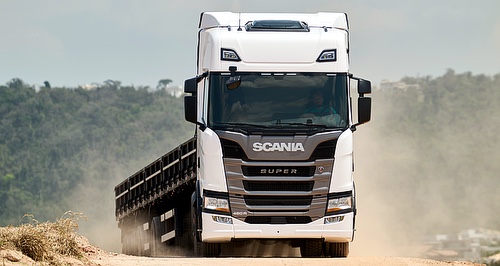Make / Model Search
News - General News - EmissionsScania MD outlines greener policy changesCHANGING GEARS: Outdated legislation a sticking point to bringing cleaner and safer trucks Down Under. Legislative changes required to bring about significant change to industry, says Scania5 Apr 2023 By MATT BROGAN THE greening of Australia’s heavy vehicle fleet is a distant dream for many of us, with current industry-best technology offerings largely out of step with both the requirements and realities of the road transport sector.
While any improvement is welcomed, battery and fuel cell technologies will not offer the immediate shot in the arm the Australian road transport sector needs to reduce CO2 and other noxious gas emissions in the here and now.
But according to Scania Australia managing director, Manfred Streit, straightforward legislative changes could immediately provide the sector with more environmentally friendly options he believes would drastically reduce the tailpipe emissions produced from our aging heavy vehicle fleet.
“One of the largest issues we have in Australia is the average fleet age of heavy vehicles,” he said.
“The average age of a truck here is 11 or 12 years and buses 16 years, which is far greater than it is in Europe, for example. In Austria, that average is four years.
“As a result, Australia is still basically at the same emissions standard for heavy vehicles today that it was in 2014 (Euro 6)…but we cannot always gain access the latest technology trucks and buses from overseas because of a number of legislative issues.”
The maximum permissible width of a heavy vehicle in Australia as well as the permitted front axle load rating are sticking points to the importation of not only the cleanest trucks and buses currently produced, but also to future BEV and FCEV vehicles which Mr Streit says will require significantly higher front axle load ratings than the 6500kg maximum offered at present.
“The low front axle weight allowance is not helpful to importing cleaner trucks and buses. Many of the newer vehicles are over that allowance now, especially electric trucks, which prevents manufacturers who are getting into BEV trucks from importing the models into Australia,” Mr Streit said.
“Certainly, if we’re going to import the bigger trucks needed to cover the greater distances in Australian then the front axle weight restriction needs to be addressed.
“The other issue is vehicle width. The maximum allowable width of a heavy vehicle here (2500mm) is narrower than in Europe, which not only means we cannot offer some of our cleaner vehicles here, but also some of our safer vehicles.
“Essentially our safety systems, and where they need to be positioned to operate to their maximum potential, make the vehicle 50mm too wide for Australian roads. We cannot sell some safety systems here because of this legislation,” he told GoAuto.
Mr Streit said changing the rules surrounding front axle load ratings and vehicle width would make it possible for importers like Scania to offer a broader range of vehicles locally, and said other changes including the subsidisation of Euro 6+ and BEV trucks and buses could further improve – and modernise – the country’s ageing fleet.
He said he believes the rules were originally created to protect locally built product, but with all new Australian trucks now imported, it was time the legislation was reviewed.
Away from those changes, Scania Australia’s managing director said it was equally important the industry remained a “safe and attractive” option for those considering a career behind the ‘wheel.
Compared to other countries, including Europe, Canada and parts of Asia, Australia’s roadside infrastructure is decidedly second class, which can deter younger and female candidates in particular from spending their work life on the road.
“The occupational health and safety side of the business is arguably better than it has ever been, but there is still room for improvement. I think we need to substantially improve the facilities offered to drivers on major highways to make the industry more attractive,” he said.
“I would also say that we need to make immigration easier for skilled drivers, because there are a lot of people who would like to come here and drive.”  Read more4th of April 2023  EVSE charges fleet futureCo-founder and chief executive says infrastructure simplification is key to EV transition3rd of April 2023  Fleet financials: Vehicle prices to stay highSenior economist explains current key financial indicators affecting fleet managers3rd of April 2023  Legal specialist highlights CoR issuesChain of Responsibility legalities a key discussion point at Brisbane Fleet Conference |
Click to shareGeneral News articlesResearch General News Motor industry news |











Facebook Twitter Instagram